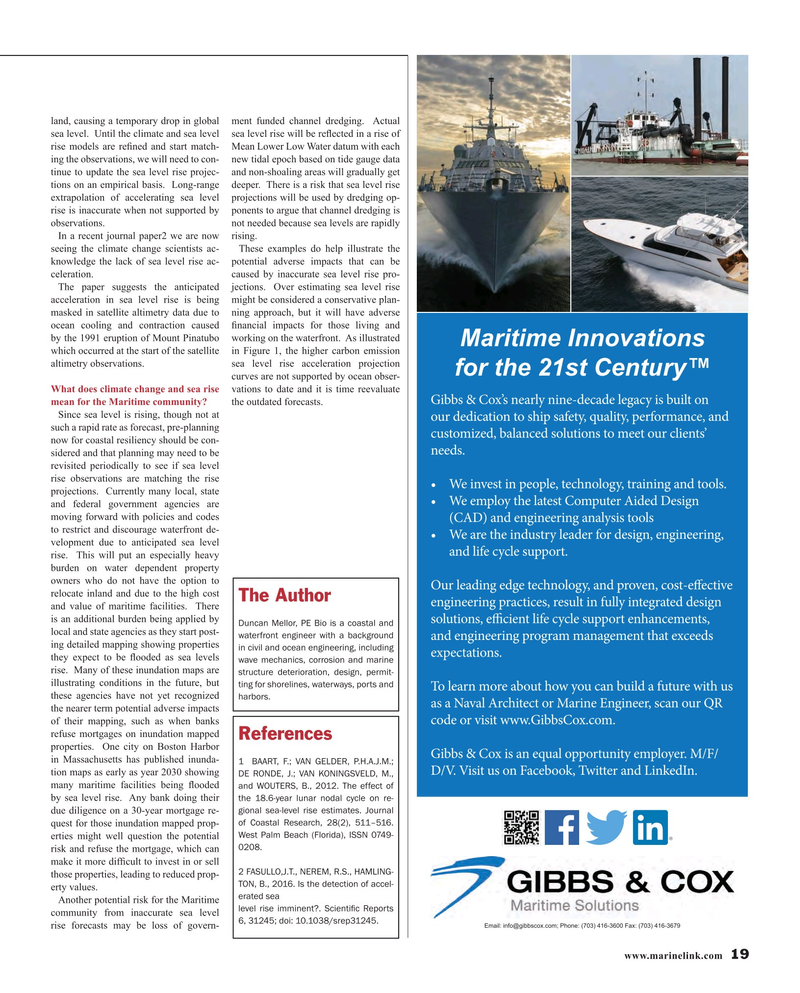
Page 19: of Maritime Reporter Magazine (October 2016)
Marine Design Annual
Read this page in Pdf, Flash or Html5 edition of October 2016 Maritime Reporter Magazine
land, causing a temporary drop in global ment funded channel dredging. Actual sea level. Until the climate and sea level sea level rise will be re? ected in a rise of rise models are re? ned and start match- Mean Lower Low Water datum with each ing the observations, we will need to con- new tidal epoch based on tide gauge data tinue to update the sea level rise projec- and non-shoaling areas will gradually get tions on an empirical basis. Long-range deeper. There is a risk that sea level rise extrapolation of accelerating sea level projections will be used by dredging op- rise is inaccurate when not supported by ponents to argue that channel dredging is observations. not needed because sea levels are rapidly
In a recent journal paper2 we are now rising.
seeing the climate change scientists ac- These examples do help illustrate the knowledge the lack of sea level rise ac- potential adverse impacts that can be celeration. caused by inaccurate sea level rise pro-
The paper suggests the anticipated jections. Over estimating sea level rise acceleration in sea level rise is being might be considered a conservative plan- masked in satellite altimetry data due to ning approach, but it will have adverse ocean cooling and contraction caused ? nancial impacts for those living and by the 1991 eruption of Mount Pinatubo working on the waterfront. As illustrated
Maritime Innovations which occurred at the start of the satellite in Figure 1, the higher carbon emission altimetry observations. sea level rise acceleration projection for the 21st Century™ curves are not supported by ocean obser-
What does climate change and sea rise vations to date and it is time reevaluate
Gibbs & Cox’s nearly nine-decade legacy is built on mean for the Maritime community? the outdated forecasts.
Since sea level is rising, though not at our dedication to ship safety, quality, performance, and such a rapid rate as forecast, pre-planning customized, balanced solutions to meet our clients’ now for coastal resiliency should be con- needs. sidered and that planning may need to be revisited periodically to see if sea level rise observations are matching the rise • We invest in people, technology, training and tools.
projections. Currently many local, state • We employ the latest Computer Aided Design and federal government agencies are moving forward with policies and codes (CAD) and engineering analysis tools to restrict and discourage waterfront de- • We are the industry leader for design, engineering, velopment due to anticipated sea level and life cycle support.
rise. This will put an especially heavy burden on water dependent property owners who do not have the option to
Our leading edge technology, and proven, cost-ef ective relocate inland and due to the high cost
The Author engineering practices, result in fully integrated design and value of maritime facilities. There is an additional burden being applied by solutions, ef cient life cycle support enhancements,
Duncan Mellor, PE Bio is a coastal and local and state agencies as they start post- waterfront engineer with a background and engineering program management that exceeds ing detailed mapping showing properties in civil and ocean engineering, including expectations. they expect to be ? ooded as sea levels wave mechanics, corrosion and marine rise. Many of these inundation maps are structure deterioration, design, permit- illustrating conditions in the future, but ting for shorelines, waterways, ports and
To learn more about how you can build a future with us these agencies have not yet recognized harbors.
as a Naval Architect or Marine Engineer, scan our QR the nearer term potential adverse impacts code or visit www.GibbsCox.com. of their mapping, such as when banks refuse mortgages on inundation mapped
References properties. One city on Boston Harbor
Gibbs & Cox is an equal opportunity employer. M/F/ in Massachusetts has published inunda- 1 BAART, F.; VAN GELDER, P.H.A.J.M.;
D/V. Visit us on Facebook, Twitter and LinkedIn. tion maps as early as year 2030 showing
DE RONDE, J.; VAN KONINGSVELD, M., many maritime facilities being ? ooded and WOUTERS, B., 2012. The effect of by sea level rise. Any bank doing their the 18.6-year lunar nodal cycle on re- gional sea-level rise estimates. Journal due diligence on a 30-year mortgage re- of Coastal Research, 28(2), 511–516. quest for those inundation mapped prop-
West Palm Beach (Florida), ISSN 0749- erties might well question the potential 0208.
risk and refuse the mortgage, which can make it more dif? cult to invest in or sell 2 FASULLO,J.T., NEREM, R.S., HAMLING- those properties, leading to reduced prop-
TON, B., 2016. Is the detection of accel- erty values.
erated sea
Another potential risk for the Maritime level rise imminent?. Scienti? c Reports community from inaccurate sea level 6, 31245; doi: 10.1038/srep31245.
Email: [email protected]; Phone: (703) 416-3600 Fax: (703) 416-3679 rise forecasts may be loss of govern- www.marinelink.com 19
MR #10 (18-25).indd 19 10/3/2016 3:24:20 PM

 18
18

 20
20
